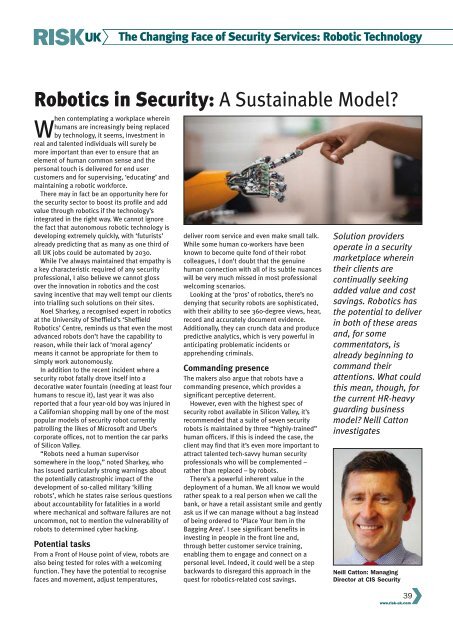RiskUKSeptember2017
You also want an ePaper? Increase the reach of your titles
YUMPU automatically turns print PDFs into web optimized ePapers that Google loves.
The Changing Face of Security Services: Robotic Technology<br />
Robotics in Security: A Sustainable Model?<br />
When contemplating a workplace wherein<br />
humans are increasingly being replaced<br />
by technology, it seems, investment in<br />
real and talented individuals will surely be<br />
more important than ever to ensure that an<br />
element of human common sense and the<br />
personal touch is delivered for end user<br />
customers and for supervising, ‘educating’ and<br />
maintaining a robotic workforce.<br />
There may in fact be an opportunity here for<br />
the security sector to boost its profile and add<br />
value through robotics if the technology’s<br />
integrated in the right way. We cannot ignore<br />
the fact that autonomous robotic technology is<br />
developing extremely quickly, with ‘futurists’<br />
already predicting that as many as one third of<br />
all UK jobs could be automated by 2030.<br />
While I’ve always maintained that empathy is<br />
a key characteristic required of any security<br />
professional, I also believe we cannot gloss<br />
over the innovation in robotics and the cost<br />
saving incentive that may well tempt our clients<br />
into trialling such solutions on their sites.<br />
Noel Sharkey, a recognised expert in robotics<br />
at the University of Sheffield’s ‘Sheffield<br />
Robotics’ Centre, reminds us that even the most<br />
advanced robots don’t have the capability to<br />
reason, while their lack of ‘moral agency’<br />
means it cannot be appropriate for them to<br />
simply work autonomously.<br />
In addition to the recent incident where a<br />
security robot fatally drove itself into a<br />
decorative water fountain (needing at least four<br />
humans to rescue it), last year it was also<br />
reported that a four year-old boy was injured in<br />
a Californian shopping mall by one of the most<br />
popular models of security robot currently<br />
patrolling the likes of Microsoft and Uber’s<br />
corporate offices, not to mention the car parks<br />
of Silicon Valley.<br />
“Robots need a human supervisor<br />
somewhere in the loop,” noted Sharkey, who<br />
has issued particularly strong warnings about<br />
the potentially catastrophic impact of the<br />
development of so-called military ‘killing<br />
robots’, which he states raise serious questions<br />
about accountability for fatalities in a world<br />
where mechanical and software failures are not<br />
uncommon, not to mention the vulnerability of<br />
robots to determined cyber hacking.<br />
Potential tasks<br />
From a Front of House point of view, robots are<br />
also being tested for roles with a welcoming<br />
function. They have the potential to recognise<br />
faces and movement, adjust temperatures,<br />
deliver room service and even make small talk.<br />
While some human co-workers have been<br />
known to become quite fond of their robot<br />
colleagues, I don’t doubt that the genuine<br />
human connection with all of its subtle nuances<br />
will be very much missed in most professional<br />
welcoming scenarios.<br />
Looking at the ‘pros’ of robotics, there’s no<br />
denying that security robots are sophisticated,<br />
with their ability to see 360-degree views, hear,<br />
record and accurately document evidence.<br />
Additionally, they can crunch data and produce<br />
predictive analytics, which is very powerful in<br />
anticipating problematic incidents or<br />
apprehending criminals.<br />
Commanding presence<br />
The makers also argue that robots have a<br />
commanding presence, which provides a<br />
significant perceptive deterrent.<br />
However, even with the highest spec of<br />
security robot available in Silicon Valley, it’s<br />
recommended that a suite of seven security<br />
robots is maintained by three “highly-trained”<br />
human officers. If this is indeed the case, the<br />
client may find that it’s even more important to<br />
attract talented tech-savvy human security<br />
professionals who will be complemented –<br />
rather than replaced – by robots.<br />
There’s a powerful inherent value in the<br />
deployment of a human. We all know we would<br />
rather speak to a real person when we call the<br />
bank, or have a retail assistant smile and gently<br />
ask us if we can manage without a bag instead<br />
of being ordered to ‘Place Your Item in the<br />
Bagging Area’. I see significant benefits in<br />
investing in people in the front line and,<br />
through better customer service training,<br />
enabling them to engage and connect on a<br />
personal level. Indeed, it could well be a step<br />
backwards to disregard this approach in the<br />
quest for robotics-related cost savings.<br />
Solution providers<br />
operate in a security<br />
marketplace wherein<br />
their clients are<br />
continually seeking<br />
added value and cost<br />
savings. Robotics has<br />
the potential to deliver<br />
in both of these areas<br />
and, for some<br />
commentators, is<br />
already beginning to<br />
command their<br />
attentions. What could<br />
this mean, though, for<br />
the current HR-heavy<br />
guarding business<br />
model? Neill Catton<br />
investigates<br />
Neill Catton: Managing<br />
Director at CIS Security<br />
39<br />
www.risk-uk.com

















